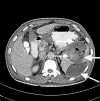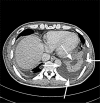Ruptured Splenic Abscess following Percutaneous Transluminal Angioplasty in a 40-Year-Old Man
- PMID: 22754495
- PMCID: PMC3383300
- DOI: 10.1159/000339463
Ruptured Splenic Abscess following Percutaneous Transluminal Angioplasty in a 40-Year-Old Man
Abstract
The incidence of splenic abscesses is currently 0.14-0.7% with a reported mortality of 0-47%. The diagnosis of splenic abscess which has ruptured into the abdomen is often overlooked because of its rarity and its misleading clinical presentations. Percutaneous coronary interventions (PCIs) and coronary stenting procedures increased from 184,000 to 885,000 (from 335 to 1,550) and from 3,000 to 770,000 (from 5 to 1,350 per one million inhabitants), respectively. A 40-year-old Asian male presented to our emergency department with upper abdominal pain 5 days after a percutaneous transluminal coronary angioplasty. Clinical examination raised the possibilities of acute pancreatitis and intraabdominal sepsis. An initial ultrasound of the abdomen and blood tests were negative. A computed tomography scan of the abdomen revealed a splenic abscess that had ruptured into the abdomen. Pus culture revealed a multidrug-resistant strain of Klebsiella pneumoniae that was sensitive to meropenem. The patient recovered quickly after open surgical drainage and antibiotic therapy. As this is the second case of splenic abscess and the first case report of a ruptured splenic abscess following a PCI, it will be rational to administer a short course of antibiotic prophylaxis for high-risk immunocompromised patients who are undergoing percutaneous transluminal coronary intervention.
Keywords: Klebsiella pneumoniae; Percutaneous transluminal coronary angioplasty; Peritonitis; Splenic abscess.
Figures



References
-
- Cook S, Walker A, Hügli O, Togni M, Meier B. Percutaneous coronary interventions in Europe: prevalence, numerical estimates, and projections based on data up to 2004. Clin Res Cardiol. 2007;96:375–382. - PubMed
-
- Stathopoulos I, Jimenez M, Panagopoulos G, et al. The decline in PCI complication rate: 2003–2006 versus 1999–2002. Hellenic J Cardiol. 2009;50:379–387. - PubMed
-
- Yost G, et al. The frequency and etiology of readmission in the 30 days after a percutaneous coronary intervention. Baltimore, Society for Cardiovascular Angiography and Interventions. 2011 abstract C-024.
-
- Sankari A, Kumar AN, Kabins S, Chandna H, Lieb D. Staphylococcal pericarditis following percutaneous transluminal coronary angioplasty. Catheter Cardiovasc Interv. 2000;50:71–73. - PubMed
Publication types
LinkOut - more resources
Full Text Sources
Research Materials
Miscellaneous

